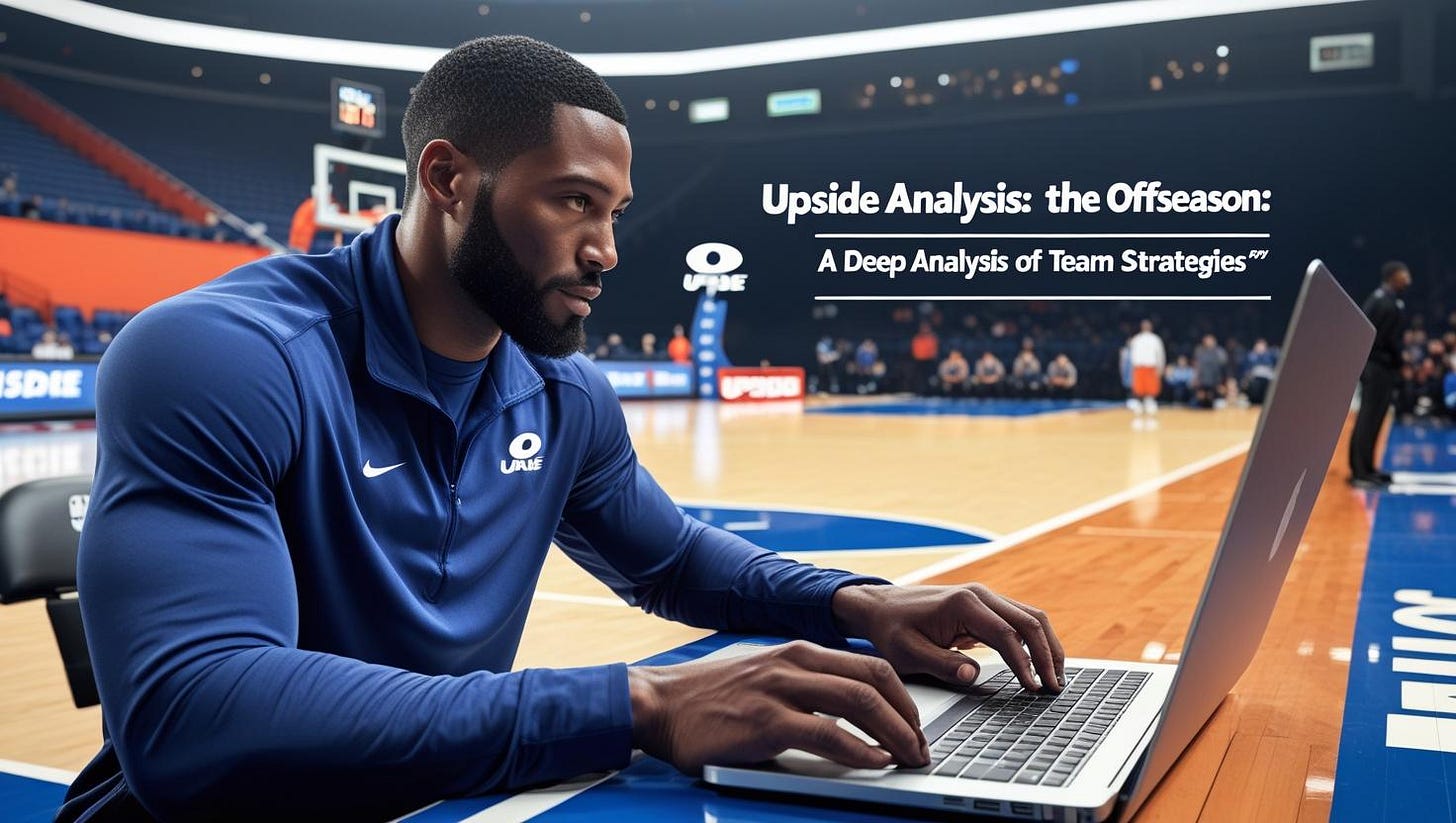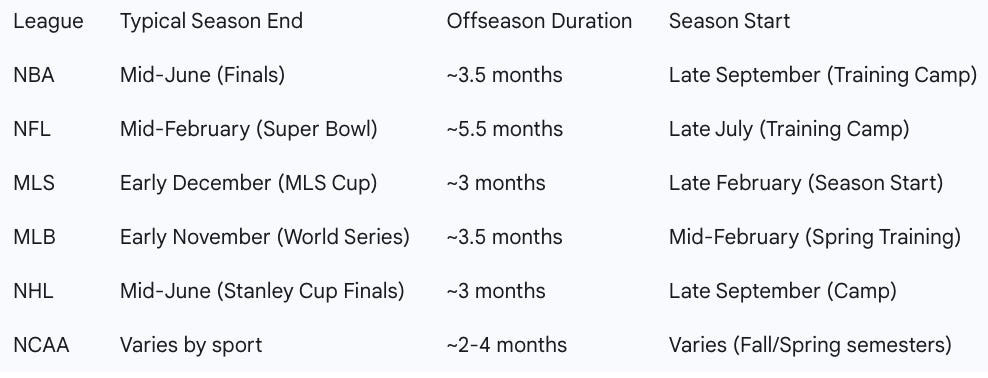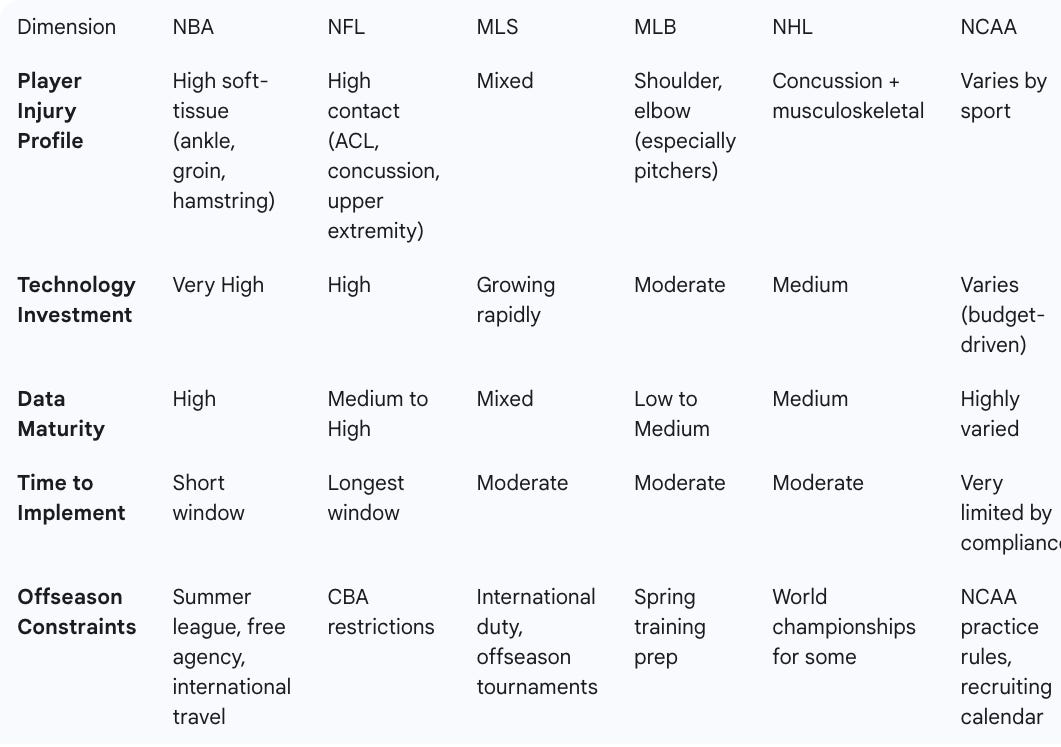📚 Upside Analysis: Maximizing the Offseason: A Deep Analysis of NBA, NFL, MLS, NHL, MLB, and NCAA Team Strategies
In professional and collegiate sports, the offseason is much more than a pause between competitions—it's a strategic opportunity. For front offices, sports scientists, strength coaches, athletic trainers, performance directors, analysts, and sports executives, the offseason is the only window to truly step back and build for the long term.
Whether it’s optimizing player health, experimenting with new technologies, restructuring performance departments, or planning data infrastructure, the offseason serves as a performance lab and business incubator. However, how teams use this time varies widely across leagues. Each league has different season lengths, injury profiles, athlete development models, and financial or compliance limitations—especially between professional leagues and the NCAA.
In this analysis, we’ll break down:
The timing of offseasons across major sports leagues,
Key priorities for practitioners during these periods,
Differences in constraints and opportunities between leagues,
And best-practice recommendations for maximizing offseason impact.
Offseason Timing Across Major Leagues
Understanding each league’s calendar is essential to assessing what’s realistically possible in the offseason.
NCAA Note: Most NCAA sports follow academic calendars. For example, football programs wrap up in December or January (bowl season), while basketball may finish in March/April (March Madness), and athletes usually return to campus in August.
Key Offseason Activities for Practitioners and Staff
1. Technology Audits, R&D, and Vendor Evaluation
Performance and medical departments use the offseason to conduct full audits of their technology stack:
Are the GPS systems collecting actionable insights?
Is the AMS being used effectively by all departments?
Do recovery tools like cryo, NormaTec, red light therapy, or force plates show ROI?
Should we trial or switch to a newer solution (e.g., Quantum Movement or Kinvent for biomechanics, Kinexon for load tracking, or ActionApps for centralized data)?
Pro Tip: The NBA and NHL often use offseason training camps to pilot tech from startups they’ve scouted during the season.
2. Performance and Injury Data Analysis
With the season’s data fully collected, the offseason becomes prime time for:
Retrospective injury audits (e.g., hamstring injury frequency, ankle sprains, chronic overuse patterns).
Load versus performance modeling (e.g., how RPE or ACWR relates to performance output or injury).
Updating player profiles with force-velocity testing, jump asymmetries, and return-to-play KPIs.
This is especially valuable in NFL and NCAA football, where contact injuries are high and the gaps between seasons are longer.
3. Facility & Infrastructure Improvements
Offseason allows for structural work that’s impossible in-season:
Installing new turf, altering court or rink dimensions.
Adding recovery lounges, rehab pools, or sleep pods.
Rewiring IT infrastructure for new video analysis or biometric systems.
Example: An MLS team may replace its natural grass pitch or install environmental control systems to mimic match conditions during training.
4. Staff Restructuring and Hiring
Performance departments often experience turnover during the offseason:
Head coaches are replaced, which ripples down to performance staff.
Teams add sport scientists, biomechanics consultants, or mental skills coaches.
Organizations may integrate nutrition, psychology, and S&C under a "High Performance" umbrella.
This is especially common in NFL and NCAA programs, which have large, tiered performance teams and frequent leadership shifts.
5. Fundraising, Donor Relations & NIL Strategy (NCAA Specific)
Collegiate programs use the offseason to:
Raise capital for facilities, staffing, or scholarships.
Host donor events, alumni games, and football "spring games."
Build NIL (Name, Image, Likeness) collectives and partnerships with brands, athletes, and influencers.
Recruit and retain athletes via portal strategies and NIL value propositions.
Example: An NCAA D1 football program may partner with a startup like Athlete Licensing Company to support its athletes’ NIL profiles during the summer.
6. Staff Development and Cross-Pollination
The offseason provides breathing room for continuing education and collaboration:
Attend conferences (e.g., MIT Sloan, Catapult Summit, Leaders in Sport).
Send staff to observe other leagues or international clubs (e.g., Premier League, Olympic training centers).
Collaborate with tech companies to design features tailored to team needs.
Example: An NBA performance team may travel to Europe to learn about structured load periodization from top soccer clubs.
League Comparisons: Constraints & Strategic Opportunities
Each league faces unique constraints and strategic considerations during the offseason:
Case Studies by League
NBA Case Study: Golden State Warriors – Offseason Built on Longevity and Innovation
The Golden State Warriors use the offseason to extend the longevity of their veteran core through highly individualized performance planning and data-driven decision-making.
Key Strategies:
Longevity Programs: Players like Curry follow custom training plans focusing on joint health, eccentric strength, and recovery.
Biomechanical Screening: Offseason assessments using force plates and motion capture identify inefficiencies and guide corrective training.
Third-Party Collaboration: Players often work with P3 for biomechanical profiling, with results shared back to the team.
Player Empowerment: Staff provide athletes with personal data dashboards, building trust and ownership in their development.
Reboot Weeks: Late-offseason training blocks help transition players back into team systems before preseason.
Impact:
Despite an aging roster, the Warriors consistently manage injuries well and keep stars ready for playoff runs—much of it rooted in their structured, tech-savvy offseason approach.
NFL: Los Angeles Rams – Integrated Sports Science Lab
The Rams use their long offseason to integrate biomechanics, analytics, and psychology:
Their in-house performance lab uses high-speed cameras and force plates for return-to-play decisions.
Offseason upgrades included a recovery suite with hot/cold contrast therapy, nutrition stations, and cognitive testing pods.
The Rams also conduct biomechanical audits using markerless motion capture during spring OTAs.
MLS: Philadelphia Union – Data-Driven Player Development
The Union are one of the most data-forward MLS franchises:
Offseason involves auditing match data, internal GPS load logs, and wellness reports to identify overuse risk.
They’ve partnered with StatsBomb and Second Spectrum for match event and tactical data layering.
The club uses the offseason to integrate Academy prospects into the senior team using phased load management plans.
NHL: Vegas Golden Knights – Recovery Optimization
The Golden Knights prioritize recovery and travel fatigue mitigation:
During the offseason, the staff revamps travel protocols, testing how sleep, hydration, and recovery tools affect performance.
The team uses biomarker testing and HRV to reset baselines after a physically demanding playoff season.
Offseason training focuses on maintaining force production while minimizing joint strain for key skaters.
MLB: Houston Astros – Customized Offseason Programs
The Astros leverage deep player analytics for offseason development:
Players receive biomechanical breakdowns and offseason pitch or swing design plans using Rapsodo, Driveline, and Trackman data.
Strength coaches tailor individualized strength programs with attention to in-season durability (e.g., scapular stability, hip rotation).
The performance team uses ForceFrame and NordBord to test eccentric strength and reduce soft tissue injuries.
NCAA: University of Oregon Football – Performance Meets NIL
Oregon’s offseason strategy blends sports science and branding:
Their facility (the Marcus Mariota Sports Performance Center) houses cryo chambers, force plates, motion capture, and cognitive training tools.
Strength staff provide players with movement screens and build position-specific off-season protocols.
The program hosts media training, NIL strategy sessions, and creates personal brand reels for NFL scouting and sponsorship.
Best-Practice Recommendations for Teams
1. Develop a Cross-Departmental Offseason Blueprint
Align medical, coaching, analytics, and performance teams with shared goals for data upgrades, recovery, and staffing.
2. Pilot Innovations Early
Trial wearables, neuromuscular training tools, or new screening protocols at the beginning of the offseason to allow time for feedback and training adoption.
3. Invest in Analytics Infrastructure
Build or refine internal dashboards that integrate GPS, HRV, RPE, and injury history into player readiness models. Use offseason to train staff on consistent data input and interpretation.
4. Conduct Player Exit Interviews and Individualized Plans
Gather holistic feedback from players post-season on everything from training loads to wellness support, nutrition, and psychological resources. Use this to build off-season development plans.
5. Benchmark Against Global Standards
Study offseason models from Premier League clubs, All Blacks Rugby, or Olympic federations that excel in periodization, travel recovery, and athlete monitoring.
6. For NCAA Teams: Operationalize NIL as a Recruiting Advantage
Build in-house content teams.
Partner with AI-driven NIL analytics tools.
Offer workshops and mentorship on brand-building and financial literacy.
7. Build Time for Deep Work
Avoid getting caught in only logistics and budget meetings. Schedule strategic workshops, think tanks, or innovation sprints that focus on “What will win us the next 2 years?”
Conclusion
The offseason is a narrow but powerful window to drive transformation in elite sports organizations. For the best-run NBA, NFL, MLS, NHL, MLB, and NCAA teams, it is a time to reflect, experiment, and evolve. Those that approach it with urgency and creativity—not complacency—position themselves for long-term competitive advantage. In a world where margins are razor-thin, and the injury landscape is rapidly evolving, the smartest teams treat the offseason not as a break, but as their biggest lever for performance, health, and innovation.
You may also like:
📈 Upside Analysis: Sales Cycle, Timeline per League to Adopt New Technologies
In elite sports, the adoption of new technologies is no longer a luxury; it is a competitive necessity. From athlete performance monitoring and injury prevention tools to scouting software and fan engagement platforms, professional teams and collegiate programs alike rely on a rapidly evolving ecosystem of technology vendors. However, knowing




